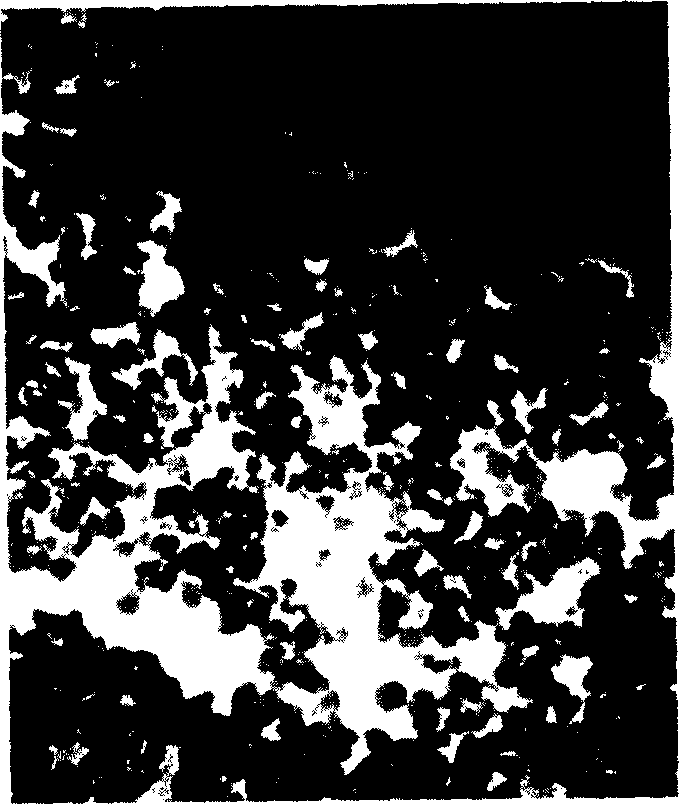Method for producing multi-layer nano composite proton exchange membrane with self-humidifying function
A proton exchange membrane and nanocomposite technology, which is applied in the field of preparation of multilayer nanocomposite proton exchange membranes, can solve the problems of large usage of precious metals, failure, self-discharge batteries, etc.
- Summary
- Abstract
- Description
- Claims
- Application Information
AI Technical Summary
Problems solved by technology
Method used
Image
Examples
Embodiment 1
[0032] Embodiment 1 has the preparation of the multilayer nanocomposite proton exchange membrane of self-humidification and water retention capacity, carries out according to the following steps;
[0033] 1. Get a porous PTFE membrane with a thickness of 10 microns, a pore size of 0.05 to 2 microns, and a porosity of 80% and fix it on a polycarbonate film with a thickness of 40 microns. 2 o 2 Wash the PTFE membrane with aqueous solution and absolute ethanol, and then dry it in a drying oven at 60°C for 20 minutes;
[0034] 2. Fully mix tetraethyl orthosilicate with a molar ratio of 1:5:0.1, absolute ethanol and 0.4M HCl mixed solution, and stir at a high speed at 70°C for 6 to 24 hours to obtain 6 nanometer SiO 2 Nanoparticles; by 5wt% Nafion solution (EW1100, purchased from Du pont company) 120g, surfactant alkylphenol polyoxyethylene 10 ether (OP-10) 1.3g, SiO 2 Nanoparticle 0.5g prepares mixed solution, the PTFE porous film that will clean is dipped in this mixed solution...
Embodiment 2
[0038] Embodiment 2 The preparation of the multilayer nanocomposite proton exchange membrane with self-humidification and water retention capacity is carried out according to the following steps;
[0039] 1. Get a porous PTFE membrane with a thickness of 20 microns, a pore size of 0.05 to 3 microns, and a porosity of 82% and fix it on a polycarbonate film with a thickness of 40 microns. 2 o 2 Wash the PTFE membrane with aqueous solution and absolute ethanol, and then dry it in a drying oven at 60°C for 20 minutes;
[0040] 2. Mix 200mL tetrabutyl titanate and 60mL acetic acid and put it in the dropping filter funnel, drop the mixed solution into 800mL deionized water under high-speed stirring at a speed of 10mL / min, continue stirring for 1 hour, and then add 15mL Concentrated nitric acid was heated to 60°C and kept stirring for 2 hours to obtain 7nm TiO 2 Nanoparticles; by 10wt% sulfonated polystyrene-polyethylene / butylene-polystyrene resin isopropanol solution 80g, OP-10 su...
PUM
| Property | Measurement | Unit |
|---|---|---|
| thickness | aaaaa | aaaaa |
| pore size | aaaaa | aaaaa |
| thickness | aaaaa | aaaaa |
Abstract
Description
Claims
Application Information
 Login to View More
Login to View More - R&D
- Intellectual Property
- Life Sciences
- Materials
- Tech Scout
- Unparalleled Data Quality
- Higher Quality Content
- 60% Fewer Hallucinations
Browse by: Latest US Patents, China's latest patents, Technical Efficacy Thesaurus, Application Domain, Technology Topic, Popular Technical Reports.
© 2025 PatSnap. All rights reserved.Legal|Privacy policy|Modern Slavery Act Transparency Statement|Sitemap|About US| Contact US: help@patsnap.com



